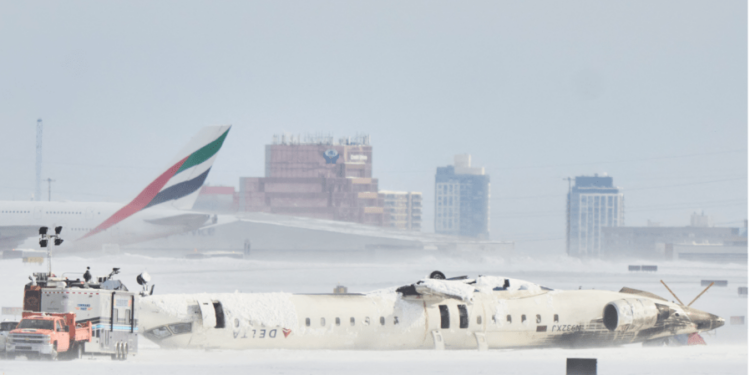
North America has now experienced four airplane crashes in the last month that have resulted in 84 fatalities. The most recent crash of the Delta regional jet in Toronto could easily have added to this total, as the wing of the airliner caught fire and flipped over on landing. Miraculously, all 80 souls aboard survived, with only 21 injuries among them, none of which were life-threatening
Amid this spate of troubling airline crashes, there will undoubtedly be calls to introduce additional measures to improve the safety of flying, but this is no guarantee of saving lives. In fact, it could easily have the opposite effect, and this is the dilemma.
The Jan. 29 crash over the Potomac near Reagan National Airport involving a collision between an American Airlines jetliner and an army Blackhawk helicopter grimly illustrates the nature of the problem.
Among the fatalities on the American Airlines flight were seven members of a party of 10 that were returning from a hunting trip in Kansas. Three of the hunters opted to drive the 1,300 miles back to Washington D.C. rather than fly. Statistically, they were roughly 100 times more likely to perish in their cross-country drive than their fellow hunters on the ill-fated jetliner. Yet they survived, and their friends did not. Such is the cold nature of probabilities.
Despite the far greater risk of driving versus flying, airline crashes attract far more attention, and this fuels a contagion that can border on the irrational. Travelers tend to dramatically underestimate the risk of driving but feel that they have some control and dramatically overestimate the risk of flying wherein they perceive that they have no control.
To put this in proper perspective, according to the National Highway Transportation Administration, approximately 40,000 individuals perish each year on the nation’s roadways. In terms of broad averages, the 84 individuals who perished in the recent spate of airplane crashes represent less than one day of fatalities on the nation’s roadways.
One plane crash that kills 70 people, because it leads the national news, is far more alarming to the general public than 35 single-vehicle automobile accidents with the same number of fatalities that are often relegated to the back pages of local newspapers.
This issue is important because the Federal Aviation Administration must be extremely judicious that any additional safety measures implemented do not cause more lives to be lost on the nation’s highways than are saved in the air.
For example, if the safety measures implemented by the FAA raise airfares, there will be some substitution of automobile travel for airplane travel. Given the significantly greater risk of driving, these policies can easily cost more lives on the ground than they save in the air.
This is not unfamiliar territory for the FAA. The agency followed similar reasoning when it determined after a lengthy study that it would not mandate child-safety seats on commercial airliners. This mandate could potentially have doubled the cost of flying for a family of four and caused them to abandon safe skies for unsafe roadways.
The disparity in injury rates between the two modes of travel may be even more concerning, As Peter Van Doren and I have previously observed, “The risk of injury in driving is almost 24,000 times greater than that of flying on a per-mile basis. The roads are dangerous and deadly — the skies are markedly less so.”
This places the FAA and recently confirmed Transportation Secretary Sean Duffy in a difficult position.
There is mounting political pressure to implement public policy measures to ease the public’s fear of flying. Concerns over the safety of flying in the aftermath of these recent crashes will prompt some travelers to substitute automobile travel for air travel, which will increase both the number of fatalities and the number of injuries. If the FAA implements safety measures that improve air safety but also increase the price of airfare the same substitution may well occur.
The FAA recently reduced the number of daily flights into Washington’s Reagan National Airport in order to reduce congestion, which is believed to be a factor in the recent American Airlines crash. The problem is that reducing the supply of flights in the face of demand that is increasing would be expected to drive up airfares. Hence, any new safety measures ordered by the FAA should not increase the safety-adjusted price of flying.
In other words, the increase in the perceived safety of flying must exceed the corresponding increase in nominal airfares.
The daunting challenge for the FAA is to thread the policy needle so to speak. It is tasked with finding some way to improve the public’s perception of the safety of flying without eliciting a significant increase in airfares.
This is de ja vu for the FAA. It has spent the last several years contemplating what to do about the recurring problems (including multiple airline crashes, safety mishaps and quality-control problems) that have plagued Boeing without a clear policy path forward.
Dennis L. Weisman, Ph.D. is a professor emeritus of Economics at Kansas State University.







